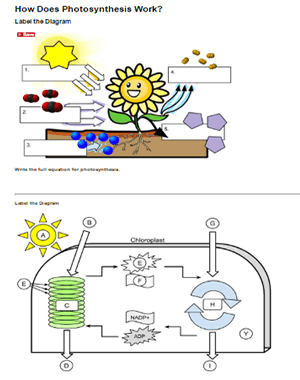
In this exercise, students label the major events that happen in photosynthesis. The graphic shows a plant with elements of showing the reactants and products. Students label each element and then write the equation for photosynthesis.
Photosynthesis is the process by which green plants, algae, and some bacteria convert light energy into chemical energy stored in glucose. It occurs in two main stages: the light-dependent reactions and the light-independent reactions (also known as the Calvin cycle).
On the second graphic, students label a chloroplast showing the light-dependent reaction with its reactants (water) and products (oxygen, ATP, NADPH.)
During the light-dependent reactions, light energy is absorbed by chlorophyll molecules in the thylakoid membranes of chloroplasts. This energy is used to split water molecules into oxygen, protons, and electrons. The electrons move through the electron transport chain, generating ATP and reducing NADP+ to NADPH.
In the light-independent reactions (Calvin cycle), ATP and NADPH produced in the light-dependent reactions are used to convert carbon dioxide into glucose. This process takes place in the stroma of the chloroplast and involves a series of enzyme-mediated steps, ultimately producing glucose, which can be used as a source of energy by the plant or stored for later use.
Other Resources on Photosynthesis
For a follow-up activity, students can connect photosynthesis to cellular respiration by examining a graphic showing how the processes are connected. The Photosynthesis and Respiration Model connects the products and the reactants for the two processes. Students highlight features of the model and answer questions.
Students can also complete the Photosynthesis Coloring where the color features of a chloroplast and the elements in an equation.
HS-LS1-6 Construct and revise an explanation based on evidence for how carbon, hydrogen, and oxygen from sugar molecules may combine with other elements to form amino acids and/or other large carbon-based molecules.

